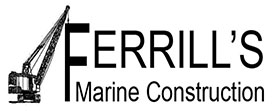Frequently Asked Questions about Marine Construction
How do I acquire a permit to start my marine construction project?
In order to acquire a permit to begin your project, a specialist from Ferrill's Marine Construction will need to come survey your property and the area in which you want your project to take place. We will take the required measurements and draw a diagram of the proposed project, fill out the application and send it to the Mississippi Department of Marine Resources (DMR) for review.
After obtaining the DMR permit we will apply for any secondary permits with the city or county officials. The Permit fees will vary.
What is a bulkhead?
A bulkhead, or seawall, is a wall built of wood or vinyl to protect waterfront properties from large storms (like hurricanes), and to protect properties from erosion and deterioration.
What is the difference between wooden and vinyl bulkhead?
Wooden bulkhead is very economical and protects property from erosion. While vinyl may last longer because of it's synthetic makeup, wooden bulkhead is less costly and still gets the job done. Built with treated wood, it is protected from parasites in the water.
While a vinyl bulkhead is a bit more costly than wooden bulkhead, it has many advantages. These include: chemical resistance, mildew resistance, and marine borers resistance. A vinyl bulkhead is very flexible and has an elasticity that can move with high pressure waves without breaking apart or caving in. Vinyl bulkhead can endure extreme heat or cold without expanding or breaking.
How long will my marine construction project take to complete?
Each customer's needs are different, therefore construction/installation times may vary. If you are simply having a boatlift installed, it could be done in the matter of a day, but more time consuming jobs, like bulkheading or pier work may take longer. Call or email us for more information.
Why a boatlift?
Boatlifts are beneficial for many reasons. First of all, because no bottom paint is needed, your boat will get greater gas mileage and speed. It will also hold its value longer. When the boat is in the lifted position, it can be easily serviced by mechanics, the out-drives rinsed with fresh water, and the zincs need not be replaced. The lift provides safety and security for your boat.
How do I know what size boatlift is right for me?
Boatlift size is determined by the weight of your boat. When deciding what size boatlift to install, the dry weight of your boat, engine size, and fuel capacity all must be taken into consideration. For example, if you own a boat that is 5,000 lbs including engine and full fuel capacity, you would need to install at least a 6,000 lb lift.
Can my lift run on 110v and 220v?
Most boatlift manufacturers offer you the option of 120v or 240v. Although some may need 240v only, boatlifts from 3,000# to 24,000# usually wire in 120v/30amp or 240/20amp power. 30,000# to 120,000# lifts require more power and higher amperage.
What warranties are provided for my lift?
Our manufacturer, Hi-Tide, Inc. out of Ft. Pierce, Florida offers great warranties for the various lifts made. The GearDrive Lift, Yacht Lift, Topless Lift, Aluminum Elevator Lift all come with 10yr. structural, 5yr. gear box, 2yr. motor, and 1yr. comprehensive warranties. The Barracuda and Aluminum Rotator Lifts offer 5yr. structural, 5yr. gearbox, 2yr. motor, and 1 yr. comprehensive warranties. Finally, the Galva-Lift, the Rotator, and the Personal Water Craft Lifts provide a 1yr. comprehensive, 5yr. gear box, and 2yr. motor warranties.
What is the difference between galvanized steel and aluminum for boatlifts?
Aluminum plants manufacture a grade of aluminum called 6061-T6. It is solid aluminum and is made to withstand the harsh elements of a marine environment. It doesn't rust and, if taken care of properly, could last for decades. The cost of the aluminum as opposed to the galvanized is more expensive, but it is a good investment because the aluminum will last much longer.
Hot dipped galvanized steel is a fabricated, raw steel dipped in zinc galvanizing. Unfortunately, over time, the galvanized coating will wear down and the exposed steel will rust the boatlift. This is especially true in lifts installed in salt water.
What about my boat and hurricanes?
In order to prevent damage to your boat due to a hurricane, the boatlift should be installed properly so that when it is in the maximum up position, the boat is well above the dock and seawall. The water would have to rise a great deal more than a normal hurricane would cause it to, just in order to make the boat float enough to damage it. The most important factor in keeping your boat safe during a hurricane is to make sure the boat is secure to the lift and that the lift is fastened into position with lines.
